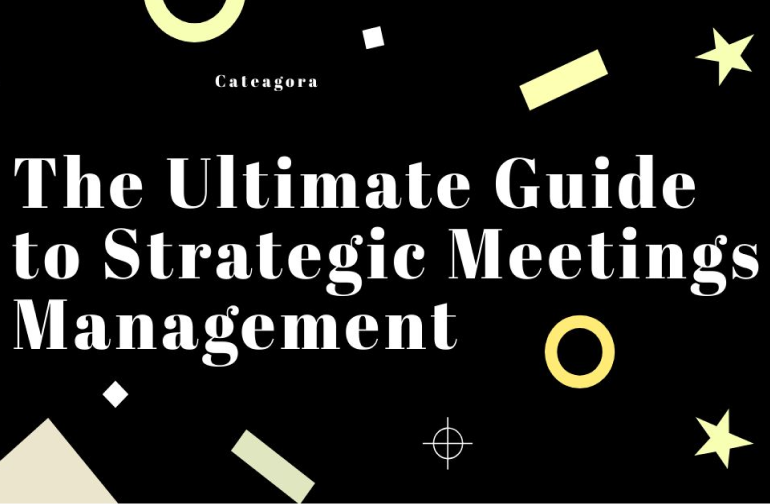Effective meetings are the heartbeat of successful business events; hence, it is crucial to strategize your corporate meetings and events to get insightful results. In this situation, Strategic Meetings Management (SMM) has appeared as a vital technique to organize and align corporate events and manage business meetings to benefit the core organization.
This blog will be your leading guide to understanding strategic meetings management, its core principles, programs and strategies, and tools and tricks to take advantage of this crucial strategy to maximize work efficiency. Explore and learn the critical components of Strategic Meetings Management and positively impact your organization’s success.
What is Strategic Meetings Management?
Strategic Meetings Management is the business term the Global Business Travel Association defines as “the disciplined approach to managing enterprise-wide meeting and event-related processes, activities, metrics, standards, and supplier strategies to achieve business objectives, quantitative cost savings, risk mitigation, and optimal service levels.”
It is the comprehensive approach organizations adopt to plan and execute essential corporate meetings, sessions, conferences, and events. This methodology helps evaluate the outcomes and gives an insight into the association with the broader goals and objectives. These management strategies optimize the meetings and events, contributing to the company’s overall success.
The primary elements of strategic meetings management include strategic planning, supplier management, data analytics, risk mitigation, and continuing the progress. It enhances attendees’ experiences and aligns meetings with the business goals.
Benefits Of Strategic Meetings Management Program
Now that we know what the Strategic Meetings Management program is. Let’s find out the key benefits of this program and how it will impact the organization’s management.
Productivity and Efficiency:
Strategic Management can boost the productivity and efficiency of the organization by utilizing technological resources and streamlining the workflow. This will aid in managing administrative tasks and focus on value-added activities, increasing the organization’s efficiency and productivity.
Cost Control:
The management program allows organizations to have better control over business expenses. This efficient meeting strategy promotes accountability and identifies overspending, reducing the risk of financial waste and leading to cost-saving.
Enhanced Visibility and Compliance:
Strategic meeting management provides visibility to the tasks and can allow the participants and the organization to track the meeting activities and other data through reporting and management systems. This will enhance communication and compliance with the organization’s policies to achieve measurable goals.
Improved Collaboration and Attendee Experience:
SMM will improve the attendees’ experience and allow them to collaborate efficiently to strategize and plan organizational objectives. SMM encourages collaborative tools that enable participants to engage and for seamless communication and collaboration, which leaves an impactful experience for the attendees.
Boost Decision-Making and Continuous Improvement:
Strategic meetings management tools provide insightful data for the meetings, which help improve decision-making and empower organizations to continuously refine their meeting and events performance for better alignment with the organization’s goals and success.
More Interesting Article:
- Ed Tech Startups Worth Knowing in 2024
- Finance Business Ideas for 2024 to Fuel Your Business Venture
- AI Business Ideas for 2024 for Rich Returns
How To Run A Strategic Planning Meeting
Let’s see how to run a strategic planning meeting to enhance the meeting performance for better organizational decision-making.
1. Define A Clear Outcome For The Meeting:
For a strategic meeting, one should define a clear purpose. Discuss the outcome with the participants. To better understand the organization’s objectives.
2. Arrange Ice Breaking Activities:
For a better discussion in the meeting, fill in the silence by engaging participants in different fun activities. Ask the participants about their opinions on previous meetings or any business challenge. Make the conversation engaging so that every participant can put forward their opinion.
3. Set Clear Meeting Expectations:
You should set clear expectations for participants to prepare for the meeting. Make sure participants know their roles and responsibilities and have a clear understanding of the meeting objectives. Set the strategic meeting agenda before it begins so participants can prepare accordingly.
4. Set Ground Rules For Behavior:
Always set rules for the meeting so that participants can follow those rules and make the most out of the meetings. For example, you set rules for participants to switch off their mobile phones to minimize distractions or be punctual to the meeting to avoid any delays. These rules will help the meeting to be more effective and purpose-driven.
5. Identify Potential Problems And Challenges:
Ensure to look for potential distractions and challenges before the meeting begins. Like if anyone has to leave halfway or handle difficult participants who took all the meeting’s time. Manage all these potential problems so the meeting can proceed smoothly.
6. Encourage Full Participation:
For the meeting, you’re asking people to take their valuable time, so ensure they can participate and express their opinions. Use language everyone in the room can understand so the contributions from participants can be more manageable.
7. Use Visual And Brainstorming Tools To Communicate Ideas:
Collaborative tools like visuals and other brainstorming tools can help people understand the meeting objectives and contribute to the discussion. Some strategic meeting management software that can help you organize the meeting seamlessly are Cvent, Meeting Decisions, Hypercontext.com, Lucidmeetings.com, and many more. You can select the software based on the organization’s needs and requirements to enhance productivity and strategic achievement.
Strategic Meetings Management Maturity Model
To assess the strategic meetings management program, the strategic meetings management maturity model provides insights on the developmental progress of the meetings to the meeting managers across 13 distinct categories. The model assesses the organization using a questionnaire and provides scores in each of the 13 categories to identify the gap and help the organization improve the meeting’s quality for better results.
The questionnaire is based on questions from 13 categories: Strategy, corporate policy, meeting registration and meetings approval process, data analysis and reporting, technology, ROI, Planning and execution, payment and expenses, Procurement, stakeholder management, communication and leadership, and resource modeling.
The index scores in the above categories will assist the organization in refining its meeting process to get better outcomes and for continuous improvement within the organization.
Closing Remarks
The business world is a little bit complicated and dense, but to make your organization’s communication and management more accessible, strategic meetings management is undoubtedly the best approach. This strategic meetings management strategy will help improve productivity and boost efficiency for the continuous success of the organization.
If you want to dive deep into doing SWOT for small businesses, read our updated 2024 guide on How to Do Swot Analysis for a Small Business.







